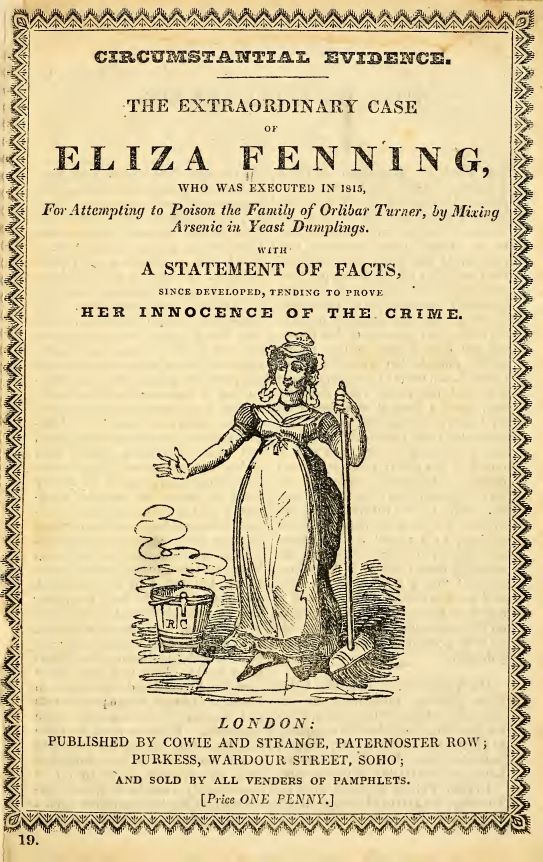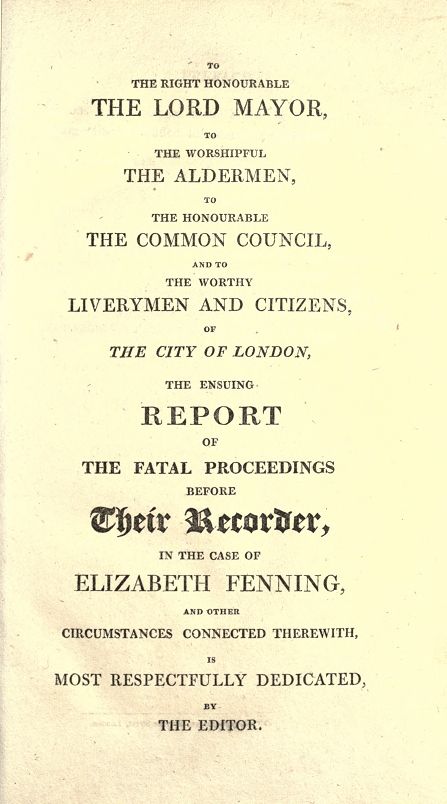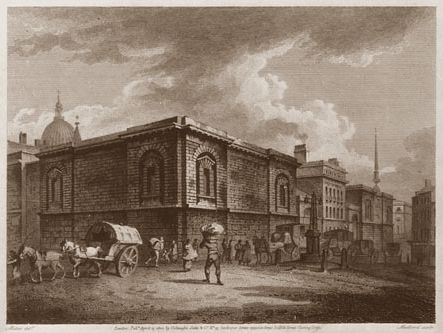On April 5th 1815 the jury at the Old
Bailey found Elizabeth Fenning guilty of breaking the peace and wounding and
she was sentenced to death by hanging. When the verdict was read out, she gave
out a scream and fainted, and was carried insensible from the courtroom. The
trial, such as it was, was flawed throughout; Mr Gurney, prosecuting, was
allowed to use leading questions at will, in effect putting words into the
mouths of the witnesses. There were many inconsistencies in the testimonies of
these witnesses that were left unexamined; not least how long the dumpling
dough was left unattended in the kitchen, when anyone could have introduced the
arsenic into it.
 |
| Elizabeth Fenning |
Mrs Turner took an extraordinary interest in the dough before
the dumplings were made, examining it on numerous occasions and commenting on
its heaviness and blackness. If she was so concerned about it, why did she
allow sub-standard dumplings to be served at her table? And if they were so
black and heavy, why did the Turners eat them? And why did the heavily-pregnant
Mrs Turner go upstairs to her room, alone and unaided, and remain there
retching and vomiting for half an hour before her husband went to attend to
her?
If the arsenic had been mixed into the dough, it would surely have been
distributed evenly throughout the dumplings, yet Mrs Turner gave evidence that
she only ate one quarter of a dumpling before she became ill and her husband
ate one and a half dumplings (six times more) and did not become ill until
thirty minutes later. Mrs Turner and Sarah Peer, the maidservant, gave
evidence, on oath, that no coals had been delivered to the house on the day of
the poisonings, yet the order book of Mr Wood, the coal merchant, showed
clearly that he had delivered twelve sacks to the Turner household on March 25th
and these twelve sacks were also metered and recorded by Westminster Land
Coal-Meter’s Office on that same date; why did the women lie about this? And
why are the questions put to Mrs Turner and Sarah Peel regarding the coal
delivery omitted from the Session’s Paper Report of the trial?
 |
| Extract from Mr Wood's Coal Delivery Day Book |
When Mr Orlibar
Turner is sworn in, the first question put to him is, “You are the father of
Mr Robert Gregson?” to which, oddly, he replies, “I believe I am.”
Why? Why not, “Yes, I am,”? Is it levity? In a trial for attempted
murder at the Old Bailey? Is his paternity a sore point? There is something
strange going on here. And this answer is changed to a blank “Yes” in
the Session’s Paper Report; again, why? Why was one apprentice, Roger Gadsden,
called to give evidence when the other apprentice, Thomas King, was not also
called? Importantly, if Elizabeth Fenning had poisoned the dumplings, why did
she also eat them? It beggars belief to say that she did so to draw attention
away from her action – who would risk arsenic poisoning to provide themself
with an alibi?
 |
| Session's Report Paper - Old Bailey Proceedings |
Another strange thing is the Session’s Report Paper’s difference
to the shorthand account taken at the trial; in the list of jurors, there is a
difference in the names of eight of them and one, Edward Beesley, a
bottle-dealer from Charles Street, is recorded as being deaf and had to have
the evidence he could not hear related to him by the other jurymen. A deaf man,
in a jury at a trial for attempted murder? Why? The case immediately drew the
attention of people who questioned the differences between the shorthand
account taken at the time of the trial and the ‘official’ version printed in
the Session’s Report Paper. Why were there so many omissions?
 |
| Circumstantial Evidence in the Extraordinary Case of Elizabeth Fenning - 1815 |
Questions were
asked about the effects of arsenic on yeast and how if arsenic was added to it,
the dough would not lose its ability to rise nor would it turn black. The
Recorder’s remarks to the jury were called into question; he had particularly
brought to their attention Dr Marshall’s evidence that he had experimented on
the residue left in serving dish and found it to be arsenic when it turned
knife blades black. Experts, in controlled conditions, made chemical
experiments and this was proved to be impossible – arsenic did not cause knives
to turn black under any circumstances.
 |
| Report in the case of Elizabeth Fenning |
A petition was sent to the Prince Regent
and another to the Lord High Chancellor, assuring them of Fenning’s innocence
and begging for mercy and a royal pardon. Fenning herself wrote to Lord
Sidmouth, Secretary of State for the Home Department, asking him to intervene
on her behalf. Most telling of all was the evidence that emerged from Mr
Gibson, of the house of Corbyn and Co, Chemists and Druggists of No 300
Holborn, who gave a written statement that in September or October of 1814, Robert
Turner had called at his house,
“… in a wild and deranged state, I invited him into a back room, or counting house, where I detained him, whilst Mr. Crockford, another gentleman in Messrs. Corbyn's house, went to his father's. In this interval, Mr. Turner, junior, used the most violent and incoherent expressions such as, ‘My dear Gibson, do, for God's sake, get me secured or confined, for, if I am at liberty, I shall do some mischief, I shall destroy myself and my wife: I must and shall do it, unless all means, of destruction are removed out of my way; therefore do, my good friend, have me put under some restraint: something from above tells me I must do it and unless I am prevented I certainly shall do it.’”
It was all to no avail for twelve hours later Elizabeth
Fenning was executed.
 |
| Newgate Prison |
On Wednesday July 26th 1815, she was brought
to the scaffold before the Debtors’ Door of Newgate prison. She was dressed in
a white muslin gown, an embroidered cap and pale lilac laced boots and mounted
the steps with a firm, calm step. Throughout the trial and up to the moment of
her death, she had maintained that she was innocent, and now she said,
“Before the just and Almighty God, and by the faith of the Holy Sacrament I have taken, I am innocent of' the offence with which I am charged.”
The hangman took a
cotton cap from his pocket and tried to put it over Fenning’s head but it was
too small, so he tried another two, which were also too small, so he took a
white muslin handkerchief and fastened it over her face. Considering his to be
insufficient, he took out a pocket-handkerchief, evidently used, and tried to
tie it about her eyes. She objected strongly, asking the Ordinary, Rev Mr
Cotton, to act,
“Mr Cotton, do not let him put it on, - pray let him take it off, - pray do, Mr Cotton,”
but
Cotton told her that she must be blindfolded. The rope was placed around her
neck, her elbows were tied by her sides and her hands bound in front of her and
she was lead up to the scaffold. The hangman threw the rope over the beam and
tied it firmly with several knots. Fenning was not very tall and Rev Cotton had
to stoop to hear her speak – the crowd assembled in the rain expected that she
was making a last-minute confession to him but actually she was asking him to
indicate when the drop was about to happen.
 |
| Broadsheet of the Execution of Elizabeth Fenning, Abraham Adams and William Oldfield - 1815 |
Two other prisoners were executed
at the same time, Abraham Adams, guilty of sodomy, and William Oldfield, guilty
of raping a nine-year-old girl, and these were brought out next and the ropes
put about their necks too. The executioner pulled his lever, the platform
opened, Fenning dropped and died without a struggle. Cotton, when asked later
why he had not given a signal to Fenning, replied that he had not done so
because
“… it saved a great deal of pain to the convict.”
Turner’s house
had to be protected from the fury of the crowds who were convinced that Fenning
had been wrongly hanged.
In a curious turn of events, a report was published in
The Times, on or about Christmas Day 1833, that Turner’s brother, in a
death bed confession, had admitted to the poisoning of the family (this was
also printed in John Timbs Curiosities of London (1855) although a
letter to Notes and Queries (July 24th 1909) states that
Turner’s nephew, annoyed at his uncle and aunt’s refusal to give him money, had
administered the arsenic and had confessed on his death bed in Chelmsford.
Another letter to Notes and Queries (August 14th 1909)
claimed that a death-bed confession had not been made by any relative of the
Turners and that Elizabeth Fenning’s execution had been used for political
purposes by opponents of the Government, as a woman had been hanged for a crime
less than murder.)
To my mind, there was doubt in the case and Elizabeth
Fenning should have been allowed the benefit of it (personally, I think Thomas
King, the apprentice, was responsible).
Very interesting, I have been studying this case for ages. Eliza was definitely innocent, that is without a doubt. I personally suspect Charlotte and Thomas King were in some kind of conspiracy, the whole house seemed to be moved by some dark secret.
ReplyDeletePersonally I think Thomas King and Charlotte most likely had something to hide and Thomas did something, Eliza saw him in the kitchen as well and he ran away. The only true thing about this case is that everyone was blatantly lying, the only one that actually does make any sense was Eliza so she was likely the only real honest one throughout this utter injustice of a trial.
This is one case that affected me personally by the injustice, still makes my blood really hot. It ridiculous.